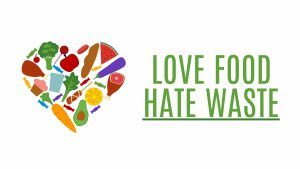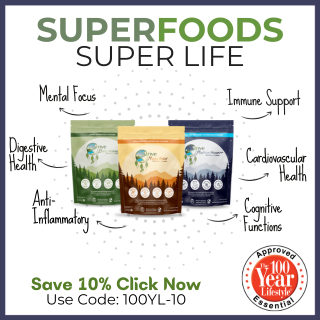Eat Healthier and Waste Less Food
Oddly enough, the holidays are a time of both overeating and food waste. Many of us go into the new year vowing to eat healthier and waste less food in the process. The 100 Year Lifestyle has some tips to help you easily achieve those goals.
- Planning is Key – Planning your meals ahead of time ticks a lot of boxes. It makes sure you don’t over-buy food or buy on impulse as you walk the grocery store isles. It also eliminates the pressure of last minute meal planning and assure that thought goes into cooking the healthiest meals for yourself and your loved ones.
- Get Out of Your Head – and write things down. Making a shopping list makes sure you get what you need and nothing more. It’s easy to lose focus when faced with isles of possibilities and an empty cart to fill up. No list ever included “impulse buys.”
- Is it really a deal? – Coupons and buy one get one free deals are only deals if you are going to eat the extra food you are buying – before it expires. Bulk buying – even of healthy food – doesn’t save time or money if it ends up in the trash
- Organize – How often have you bought an item at the grocery store because you were sure you were out, only to find it hidden in the back of the pantry or disguised in an unlabeled container in the back of the fridge? By organizing your food inventory and making everything visible, dating when necessary, you will avoid over-purchasing and tossing unused food.
- Know How to Store – Many of us know the basics of storage. We have drawers in our refrigerators labeled for high-humidity items (leafy greens) and low-humidity drawers for veggies that rot easily (mushrooms and peppers). We might even have proper food storage containers. But do you know what lasts longest when stored at room temperature? And here’s the $1 million question – do you know what fruits and vegetables shouldn’t be stored together? There are a few things to know in order to keep your food fresh longer. You can start your learning process here.
- FIFO – First in, first out is important. How many times have things you were planning to eat expired or gone bad because you held on to them longer than you thought you had? Pull the older food items in your pantry and fridge to the front and put newer items behind so that you are always eating food in a timely manner.
- LLL – Learn to Love Leftovers – Here’s where your creativity comes into play. Everyone knows that leftovers mean lunch. But that doesn’t mean it has to be a total replay. Leftover pasta, with a few fresh ingredients, can become pasta salad. Cooked vegetables can become a grilled sandwich, mixed with rice for a pilaf, or made into a warm soup. Think outside of the box and leftovers don’t need to be boring.
- Share – Really overdo it with the cooking? Share your leftovers with a friend or coworker. For health reasons, local food banks cannot accept cooked or prepared foods. However, if you overdid it with purchasing, donate your fresh, boxed, or canned foods to your local food bank before their expiration date.
- Use Your Freezer – So many of us forget that many items can be frozen to preserve their freshness and extend their life. Everything from fresh fruits, vegetables, and herbs to bread, soups, and more can be easily frozen to extend their life! Remember, however, that even frozen foods have a shelf life so write a date on the container before freezing.
- Eat Ugly – Whether shopping at the store or farmer’s market or pulling food out of our own refrigerator, remember imperfect or ugly produce is still delicious! Unfortunately, even grocery stores turn away produce that doesn’t meet their strict cosmetic standards. This is said to account for 40% of total food waste – before you even take the food home. Buying ugly produce at the store will save you money and start to put a dent into our national food waste. But even perfect produce will start to turn ugly at home. If it can be safely eaten by removing a wilted leaf or cutting out a brown spot and then eating or freezing – do it!
- Stalks, Stems, and Seeds – Be sure to eat it all! Recipes are great guidelines – but they also encourage waste! Broccoli stalks are still part of the broccoli and celery leaves, cilantro stems, and pumpkin seeds right out of the pumpkin are all delicious and edible! Before you toss or even compost, make sure you’re not tossing something tasty.
- Peel Less – In keeping with #11 above, stop peeling your food. Potato, carrot, apple, and cucumber skins – to name just a few – are perfectly edible. A good cleaning with a vegetable scrubber is all they need.
- Trash to Treasure – There is inedible waste in the kitchen. However, onion peels, meat bones, and other such things can be saved (you can even freeze them until you’re ready) and turned into rich, delicious stock for soups or to be used in cooking.
- Good to the Last Drop – Do a search of the zillion ways to use the brine from that jar of pickles. Put some oil and vinegar into that bottle of mustard for a zestier salad dressing. Use the bottom of the jar jam to make a tasty marinade for chicken. Turn that jar of mayo upside down to get out the last drop. A little creativity will provide tasty results!
These are just a few of the ways that you can stop food waste in your own home, eat healthier, and save money every day. Educate yourself and your family, then see what other ways you can come up with that will work for you! It’s good for your health – and the health of the planet!
- SHARE THIS POST
Facebook
Twitter
LinkedIn
Email
Print








